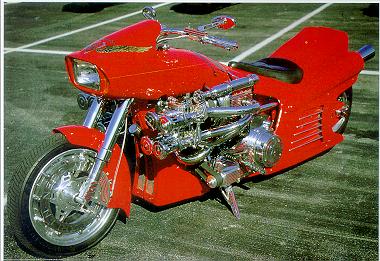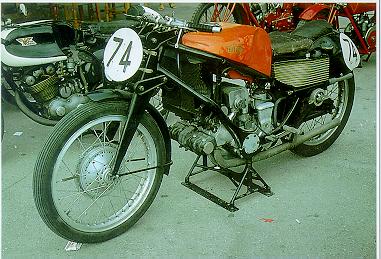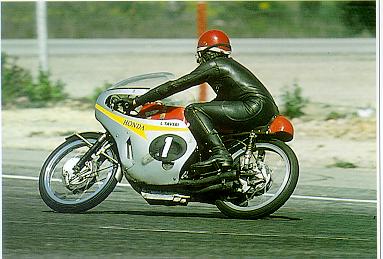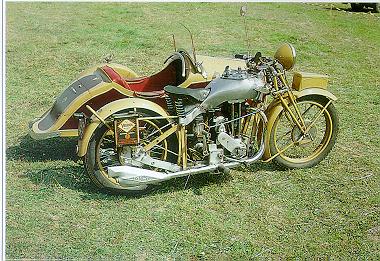Kunis' Photo Gallery with some interesting motorcycleslanguage switch to Dutch This page contains information and pictures of the following motorcycles:
type: 500cc V4 with compressor year of manufacture: 1939 country of origin: Great Britain
The legendary British trademark AJS was started in 1909 by machine manufacturer Joe Stevens in Wolverhampton. In the thirties, AJS was one of the companies which knew the right way to build multi-cylinder engines. The age of single cylinder motorcycles seemed to have passed, for racers as well as touring models. At the London motorcycle show of 1935, AJS presented the prototype of a four cylinder touring motorbike with air cooling, which has never been produced, except for a single race model. In 1938, a new version was introduced with a supercharger mounted at the front. The motorbike was fast, but its acceleration was not very good and had overheating problems. AJS re-engineered the four cylinder motorcycle, and came up with a liquid cooled model and an improved frame in 1939. This might have made the motorcycle a success, but due to the world war it never was. In the first year of the world war, the motorcycle earned eleventh place in the British TT. After the war, it raced in 1946 twice before being placed in a museum. Specifications: 4 stroke 50 degrees V4, liquid cooled, 494 cc (50 x 63 mm), 55 HP at 7200 rpm, 2 x SOHC with chain drive, ignition by twin magnetos, fuel supply with Zoller supercharger, primary and secondary chain drive, 4 gears, drum brakes, maximum speed over 160 km/h. Apart from the corny styling, the AJS four cylinder from 1939 was mechanically very modern. Modern supersport motorbikes have many similar elements. trademark: Arlen Ness type: "The Big Red" year of manufacture: 1991 country of origin: United States
The Californian motorspecialist Arlen Ness, the best Harley-Davidson tuner, had only one dream: to built worlds biggest dragster. After five years this dream came true. Ness invested about $100,000 of his own money in his dream project. As starting point he took the 1200 cc engine of a Harley-Davidson. He took the huge pistons from an 8 cylinder Chevrolet, and he gave each cylinder a supercharger and two double carburetteurs. For the back wheel, he chose a huge Pirelli car tyre of 265/60 x 16". Because a dragster has to accelerate fast, Ness used a technique which was used in World War II in aeroplanes. It was an injection of nitro oxygen which increased the power by 40%. Specifications: 2-cylinder V-engine, air-cooled, 2089 cc, o.h.v. engine, 2 superchargers, 4 twin choke Dell'Orto carburretteurs and Nitro injection, double secondary transmission, aluminium frame, upside-down frontfork, solid back end, twin front disc brakes, twin back disc brakes, backtyre 265/60 x 16", 5 years of building time, abnormal performance. type: 600 cc year of manufacture: 1924 country of origin: Czechoslovakia
Already in the beginning of the 20th century Czechoslovakia was playing an important role in the European motor industry with many original ideas. In 1905, Laurent Klement (later Skoda) had a four cylinder chain-driven motorbike. The BD_Praga from 1927 was the first motorbike with DOHC, 39 years before Honda had one. A Czech motorcycle was in 1923 the first with an electrical starter. The Bohmerland (Bohemenland) was produced from 1920 until 1939. The Liebisch engine was very traditional, but the long and strong frame was very modern. The Bohmerland was available in a version that could ride 140 km/h with one or two seats. Specifications: 1-cylinder 4 stroke, air cooled, 603 cc (80 x 120 mm), 20 HP at 3500 rpm, magnet ignition, 3 gears, leading link front fork, friction suspension, light metal 19" wheels, 180 kg mass, maximum speed 120 km/h. type: "Reitwagen mit Petroleum Motor" year of manufacture: 1885 country of origin: Germany
From the middle of the 19th century, people were thinking about motorising bicycles. The first attempts are from 1864, when the French Michaux and Perreaux mounted a steam engine on their bikes. S.H. Roper did almost the same in the United States, but used a petrol internal combustion engine instead of steam. In fact it is coincidence that the first actual motor vehicle was one with two wheels. The German Gottlieb Daimler in 1885 built a one cylinder motorcycle with a mechanical exhaust valve and an automatic input valve. First he tried the machine in a boat and a carriage, and later he mounted it in a massive wooden chassis on two wheels. In that way Daimlers "Reitwagen mit Petroleum Motor" was born. When his 2 cylinder engine was working properly, Daimler started to work with four wheels. He did this with Carl Benz, and this was the beginning of one of the most famous car manufacturers, Daimler-Benz. Later this became Mercedes-Benz. Specifications: Single cylinder 4-stroke with forced air cooling, 264 cc, 0,5 HP at 700 rpm, mechanical exhaust valve and automatic input valve, vaporization carburetteurs, glowtube ignition, handstart, wooden chassis with extra wheels, bar steering, wooden wheels with metal tyres, mass 90 kg, maximum speed 6 to 12 km/h. Daimler's wooden motorcycle burned in 1903, but there are replicas in museums in Munchen, Neckarsulm and Augsburg. trademark: Gilera type: 500 cc Rondine with supercharger year of manufacture: 1937 country of origin: Italy
The Gilera Rondine was designed by Taruffi, and was very advanced for its time. The model was an inspiration for the next generation of Italian motorcycles, and for the Japanese. With the use of a supercharger, the Rondine produced 80 HP at 9000 rpm, very high for that time. The Rondine had many successes, such as the race Milan-Tarente in 1938 and the European sidecar race of 1939 where speeds of 180 km/h were reached. The Rondine has become famous with the record of Piero Taruffi; in 1935 he reached the speed of 244.5 km/h with an unfaired model of the Rondine, and in 1937 he reached the speed of 274.2 km/h with the faired model shown in the picture. Specifications: 4-cylinder 4 stroke, liquid cooled, 492 cc (52 x 58 mm), DOHC driven by cog-wheels, Weber carburetteurs and a Roots supercharger, 4 gears, chain driven, front tyre 3.00 x 21" back tyre 3.25 x 20", tank 22 litres, mass 180 kg, maximum speed 220 km/h. trademark: Moto Guzzi type: 500 cc V8 Grand Prix year of manufacture: 1955 country of origin: Italy
The engineers of Moto Guzzi have been some of the most creative in the motorcycle industry. The 500 cc V8 Grand Prix, designed by Giulio Carnaco, is evidence of this. This V8 engine is unique in the history of the motorcycle, because it poses technical problems which no other manufacturer ever solved. There were alternatives, but they weren't the same as the 500 cc V8 of Moto Guzzi. Examples include the Galbusera V8 from 1938, but that was a two stroke engine. In 1979 Honda made the NR 500, but this was like a V4 with double pistons. Specifications: 8 cylinder 4 stroke V engine, liquid cooled, 2 DOHC's, 499 cc (44 x 41 mm), 78 HP at 12000 rpm, 8 Dell'Orto 20 mm carburretteurs, choice of 4, 5 or 6 gears, drum brakes, front tyre 2.75" x 19", back tyre 3.00" x 20", mass 150 kg, maximum speed 275 km/h. trademark: Honda type: 125 cc RC 149 Grand Prix year of manufacture: 1966 country of origin: Japan
In the sixties, the Japanese manufacturers became more popular in Europe. In the world championships of the 125 cc class there was a big technological battle. In the 50 and 125 classes, Honda became the champion of the 4 stroke motorcycles with their five cylinders engines. Later Honda also became champion in the two cylinder and the four cylinder classes. After 1967, it was no longer permitted to use more than two cylinders in the 50 and 125 classes, and more than four cylinders in the higher classes. Specifications: 5 cylinder in line, 4 stroke, air-cooled, 124.4 cc (35.5 x 25.14 mm), 34 HP at 20500 rpm, max revolutions 23000 rpm, DOHC, 4 valves per cylinder, 5 carburretteurs, magnesium crankcase, electronical ignition, 9 gears, chain driven, drum brakes, tyres 18", mass 85 kg, max speed 210 km/h. The Swiss racing motorcyclist on small motorcycles, Luigi Taveri, won the worldchampionship three times on the Honda 125 cc. trademark: Honda type: NR 750 prototype year of manufacture: 1990 country of origin: Japan
Before Honda made the NR 750, it had the RC30, the most advanced motorcycle. But after that, the engineers of Honda constructed the NR 750. The history of the NR 750 started in 1979 when Honda started to race at the race circuit with a Grand Prix four stroke. These V4's had four oval cylinders, each with two bars between the piston and the big-end and with eight valves per cylinder. Actually it was a V8 with two cylinders taken together. Despite this technical miracle, the first NR wasn't a success. The oval pistons design was by Irimajiri, who had previously designed a 250 cc six cylinder and the CBX 1000 six cylinder of 1978. The problems with the NR prototype where solved after ten years, and in 1990 the Honda NR 750 finally became popular. This motorcycle is Honda's top product in design as well as technology. Specifications: 90 degree V4 4 stroke, 360 degrees crankshaft, liquid cooled, 748 cc (75.3 x 42 mm), 130 HP at 14.000 rpm, oval pistons, 2 x DOHC, 8 valves per cylinder, electronic multipoint fuel injection, 6 gears, chain driven, 3 disc brakes, tyres 17", mass 223 kg. trademark: Indian type: 1265 - Four Model 441 year of manufacture: 1941 country of origin: United States
The Harley Davidson is the only manufacturer from all of American motorcycle history which still exists. But in the past there were many more motorcycles types, like the Indian 441. The model in the picture is one of the most beautiful American four cylinder motorbikes. The enormous mudguards are very typical for the American style in these years. After 1942 this model wasn't produced anymore, so this is the last American four cylinder motorcycle. Specifications: 4 cylinder, 4 stroke, air-cooled, 1265 cc (69.9 x 82.6 mm), 40 HP, single Schebler carburretteurs, 3 manual gears, Indian 4.50 x 18" or 5.00 x 16" tyres, mass 258 kg, maximum speed about 160 km/h. type: 1000 cc recordmachine year of manufacture: 1935 country of origin: France
This motorcycle is known as one of the most beautiful French racing machines of all time. Only 13 of this type were built between 1927 and 1935. The model in the picture is from the racing motorist Georges Monneret and is a unique sample. The first model of 1927 produced 35 PK at 5500 rpm, and due to this power the owner had to put special glue on the rim to prevent slipping at the start. It was one of the most modern motorcycles in that time which made unique performance. The Koehler Escoffier was tuned by Georges Monneret up to 78 HP when using alcohol as fuel. Specifications: 4 stroke, 45 degrees V twin engine, air-cooled, 980 cc (79 x 100 mm), 78 HP at 6200 rpm (on alcohol), 2 x SOHC, 2 Amal RN carburators, magneto ignition, 4 gears, drum brakes, front tyre 21", back tyre 19", mass about 180 kg, maximum speed 200 km/h. trademark: Laverda type: 1000 V6 Enduro year of manufacture: 1978 country of origin: Italy
In the seventies Laverda contributed to the increasing popularity of Italian motorcycles by selling a 750, 1000 and a 1200 cc motorcycle. The brothers Piero and Massimo Laverda where very ambitious, despite their financial problems. They instructed Giulio Alfieri, the designer of the famous V12 Maserati engine, to make a very complicated engine for a Laverda race model. Alfieri was one of the most talented engine designers, but although he did not have much experience with motorcycles, he learned quickly, and in 1977 a prototype was presented in Milan. The six cylinder was fast, but it was heavy to handle. The manufacturer has now been taken over by Japanese companies. Specifications: 6 cylinder, 4 stroke, 90 degrees V-engine, liquid-cooled, 995 cc (65 x 50 mm), 140 HP at 11,000 rpm, 4 OHC's, 4 valves per cylinder, 6 carburetteurs (32 mm), 5 gears, 3 disc brakes, mass 220 kg, maximum speed 285 km/h. type: 640 cc racer year of manufacture: 1923 country of origin: Germany
The twenties were very interesting times in the development of vehicles, and also of motorcycles. The most important was technical development rather than marketing. One of the most remarkable designs comes from Friz Cockerel, who designed a motorcycle between 1921 and 1925 which has the engine in the front wheel. This was the Megola, of which about 2000 were sold. The 5 cylinder star-engine was mounted in the front wheel, and the wheel turned around six times slower than the crankshaft did. It has only one carburetteur. The Megola doesn't have a clutch, so it has to be push started. Specifications: Rotating 4 stroke, 5 cylinders in the front wheel, magneto ignition, 640 cc (52 x 60 mm), 14 HP at 5000 rpm, no gears, 2 drum brakes on the back wheel, tank 14.7 litres, maximum speed 143 km/h. type: 600 cc N 3 A year of manufacture: 1933 country of origin: France
There were only 250 M.G.C.s sold, and only 30 still exist, so it is a collector's item. After working a while at Hispano-Suiza, Marcel Guiguet started to construct motorcycles in 1929. The result was that in 1930 a motorbike was sold where the buyer could choose the engine. It was produced until 1936. The M.G.C. had a British JAP engine and a fuel tank of 15 litres. The trademark of Hispano-Suiza, a stork, inspired the styling of Guiguets design. The tank depicted the trunk of the bird, and exhaust system depicted its leg. The triangular toolbox on the front mudguard depicted the bill. Only two motorcycles of this 600 cc type were built. Specifications: 1 cylinder JAP-engine, 4 stroke, air-cooled, 600 cc (85.7 x 104 mm), about 25 HP at 4500 rpm, magneto ignition, Sturmey Archer manual 4-speed gearbox, chain driven (primary and secondary), drum brakes, 19" tyres, mass 180 kg, maximum speed 125 km/h. With the speedometer, clock, fuel gauge, ammeter and lightswitch, the dashboard of the M.G.C. is very modern. type: 708 cc four valve year of manufacture: 1926 country of origin: Germany
The first motorcycle design was pretty good, so the years following produced little change. In 1922, a 3 speed gearbox was mounted in the engine of the 616 cc V2. The model had no rear suspension. In 1928, the Wanderer got a 750 cc engine. The buyer could choose between a 2 and a 4 valve engine. A brake on the front wheel was also introduced in that year. The electrical parts of this motorbike were delivered by Bosch, and it could reach a speed of 120 km/h. Specifications: 2 cylinder, 4 stroke, 45 degrees V-engine, air-cooled, 708 cc (70 x 92 mm), 4 valves per cylinder, 2 Amal-Fischer carburetteurs (22 mm), chain driven, kick-starter, 26" tyres, maximum speed 120 km/h. type: 350 "Flying Banana" year of manufacture: 1920 country of origin: Great Britain
Generally, English builders have a conservative reputation, but there are some very creative exceptions, like John Wooler. Before and after World War II, Wooler became famous with his irregular designs, in which light weight and easy maintainance were very important. You can also see this in his logo, a double key with the word "accessibility". The design only uses two nuts sizes, (a 6 and 8 mm one) apart from the nuts for the wheels and the crankshaft. Due to the yellow tank, the design of Wooler's got the nickname "Flying Banana". The 345 cc version from the twenties has a power of 2.75 HP, and was very economical. In an official test of 500 km, the motorcycle only used 5 litres of gas. This was due to a single carburetteur with moulded inlet parts and a crankcase which was mounted below the cylinders, so much warmth was available to evaporate the fuel. Specifications: flat 2 cylinder, 345 cc (60.5 x 60 mm), B & B carburetteur, CAV magnet, 9 gears, tyres 26 x 2.25, mass 76 kg, maximum speed 100 km/h (Brooklands Special version). The strange reservoir of the Flying Banana was a removable reserve tank. Jeroen Kunis created, designed, translated and maintains this page. Thanks to Loren Wilton and Peter Hammond for passing corrections regarding the translation. For comments you can send him e-mail at homepage at kunis dot nl. Last change: May 17, 2008 |




























